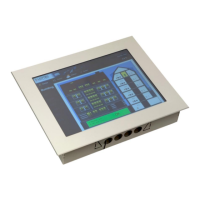L-VIS User Manual 202 LOYTEC
Version 6.2 LOYTEC electronics GmbH
analog data point, the server object type analog input, analog output, or analog
value can be chosen.
Commandable: This property defines if the underlying BACnet server object is
commandable. For BACnet value objects (AV, BV, MV) this property can be
edited to create commandable or non-commandable BACnet value objects.
Relinquish to invalid value: This property defines whether the data point
maintains the Relinquish_Default value when the priority array is empty, or
assumes the invalid value. By default, this property is false and the
Relinquish_Default value is used. Setting this property to true can be beneficial
when used in a connection to withdraw a value in another technology.
Server Object Name: This property defines the object name of the underlying
BACnet server object. It must be unique among all server objects. It can be up to
64 characters.
Server Object Instance No: This property defines the object instance number of
the underlying BACnet server object.
Server Object Description: This property defines the object description of the
underlying BACnet server object. It can be left blank.
Server Object Device Type: This property defines the object device type of the
underlying BACnet server object. It can be left blank.
Get Active Priority: Set this check box to let the data point reflect the active
priority of the local or remote BACnet object. The priority is a number between 1
and 16. This property is only applicable for commandable BACnet objects.
Allocate Server Object: This property defines whether a server object shall be
allocated for the data point. This option is useful when a local server object shall
be allocated for a client mapping.
Allocate Client Mapping: This property defines whether a client mapping shall
be allocated for the data point. This option is always set when at least on client
mapping is attached.
Client Map Count: This property defines the number of client mappings
attached to a data point. A data point can have one read client map or n write
client mappings.
Client Map [n]: This is a list of client mappings. The property shows a summary
of the client mapping parameters.
Client Confirmed COV: This property defines whether a client map subscribes
with the confirmed COV service. If disabled, unconfirmed COV is used.
Client Map Type: This property determines the type of client mapping. It can be
one of the following: Poll, COV, Auto, Write, or Value (see Section 10.5.1).
Client Write Priority: For a write or value client map, this property defines
which priority is used for writing.
Remote Instance Number: This property specifies the object instance number of
the remote server object. The object type cannot be edited.
Value Read Mode: For value client mappings, this property defines the read
mode: Poll, COV, or Auto.
10.6.6 Modbus Properties
Apart from the common data point properties discussed in Section 10.6.3, Modbus data
points have the following additional properties:
Modbus Device Name: This property defines the name of the Modbus slave
device which contains the data point.

